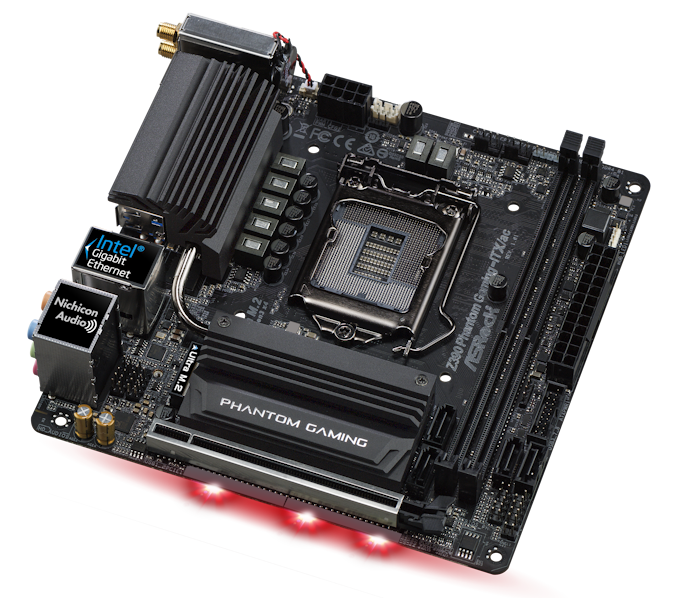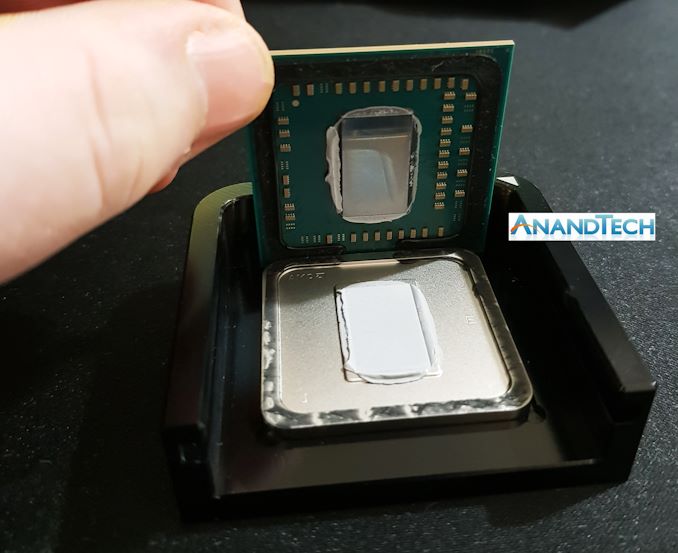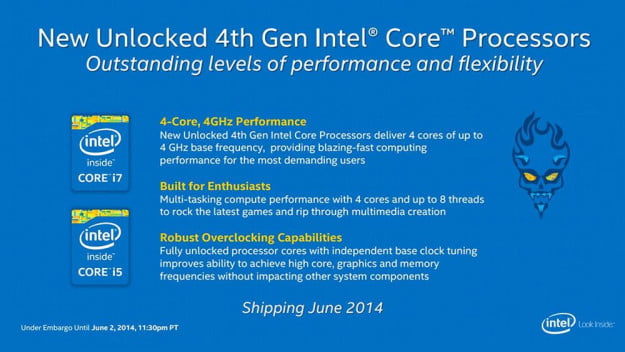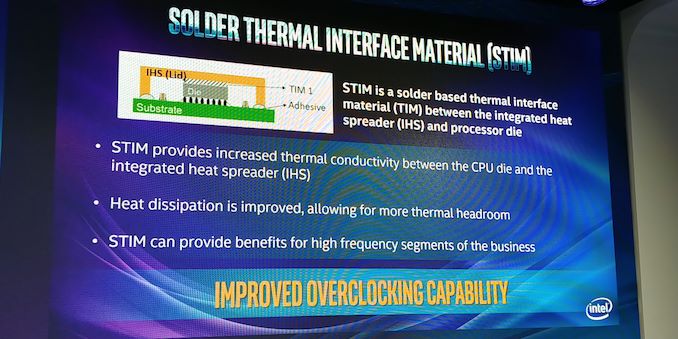The Intel 9th Gen Review: Core i9-9900K, Core i7-9700K and Core i5-9600K Tested
by Ian Cutress on October 19, 2018 9:00 AM EST- Posted in
- CPUs
- Intel
- Coffee Lake
- 14++
- Core 9th Gen
- Core-S
- i9-9900K
- i7-9700K
- i5-9600K
Hardware and Software Security Fixes
The Spectre and Meltdown vulnerabilities made quite a splash earlier this year, forcing makers of hardware and software to release updates in order to tackle them. There are several ways to fix the issues, including software, firmware, and hardware updates. Each generation of product is slowly implementing fixes, including some of the new 9th Generation processors.
At this point Intel has split the list down into 5/6 wide variants of different types of vulnerabilities. For all processors beyond mid-2018, here is what the fix table looks like:
| Spectre and Meltdown on Intel | |||||||
| AnandTech | SKX-R 3175X |
CFL-R | Cascade Lake | Whiskey Lake |
Amber Lake |
||
| Spectre | Variant 1 | Bounds Check Bypass | OS/VMM | OS/VMM | OS/VMM | OS/VMM | OS/VMM |
| Spectre | Variant 2 | Branch Target Injection | Firmware + OS | Firmware + OS | Hardware + OS | Firmware + OS | Firmware + OS |
| Meltdown | Variant 3 | Rogue Data Cache Load | Firmware | Hardware | Hardware | Hardware | Firmware |
| Meltdown | Variant 3a | Rogue System Register Read | Firmware | Firmware | Firmware | Firmware | Firmware |
| Variant 4 | Speculative Store Bypass | Firmware + OS | Firmware + OS | Firmware + OS | Firmware + OS | Firmware + OS | |
| Variant 5 | L1 Terminal Fault | Firmware | Hardware | Hardware | Hardware | Firmware | |
The new 9th Generation processors, listed as CFL-R (Coffee Lake Refresh), has implemented hardware fixes for variant 3, Rogue Data Cache Load, and variant 5, L1 Terminal Fault.
Because the new chips have required new masks for manufacturing, Intel has been able to make these changes. The goal of moving the changes into hardware means that the hardware is always protected, regardless of OS or environment, and with the hope that any additional overhead created by a software fix can be lessened if done in hardware.
(S)TIM: Soldered Down Processors
With the desktop processors we use today, they are built from a silicon die (the smart bit), a package substrate (the green bit), a heatspreader (the silver bit), and a material that helps transfer heat from the silicon die to the heatspreader. The quality of the binding between the silicon die and the heatspreader using this thermal interface material is a key component in the processors ability to remove the heat generated from using it.
Traditionally there are two different types of thermal material: a heat conductive paste, or a bonded metal. Both have positives and negatives.
The heat conductive paste is a universal tool – it can be applied to practically any manufactured processor, and is able to deal with a wide range of changing conditions. Because metals expand under temperature, when a processor is used and gets hot, it expands – so does the heatspreader. The paste can easily deal with this. This allows paste-based processors to live longer and in more environments. Using a bonded metal typically reduces the level of thermal cycling possible, as the metal also expands and contracts in a non-fluid way. This might mean the processors has a rated lifespan of several years, rather than a dozen years. However, the bonded metal solution performs a lot, lot better – metal conducts heat better than the silicon-based pastes – but it is slightly more expensive (a dollar or two per unit, at most, when the materials and manufacturing are taken into account).
| Thermal Interface | |||||||
| Intel | Celeron | Pentium | Core i3 | Core i5 | Core i7 Core i9 |
HEDT | |
| Sandy Bridge | LGA1155 | Paste | Paste | Paste | Bonded | Bonded | Bonded |
| Ivy Bridge | LGA1155 | Paste | Paste | Paste | Paste | Paste | Bonded |
| Haswell / DK | LGA1150 | Paste | Paste | Paste | Paste | Paste | Bonded |
| Broadwell | LGA1150 | Paste | Paste | Paste | Paste | Paste | Bonded |
| Skylake | LGA1151 | Paste | Paste | Paste | Paste | Paste | Paste |
| Kaby Lake | LGA1151 | Paste | Paste | Paste | Paste | Paste | - |
| Coffee Lake | 1151 v2 | Paste | Paste | Paste | Paste | Paste | - |
| CFL-R | 1151 v2 | ? | ? | ? | K = Bonded | - | |
| AMD | |||||||
| Zambezi | AM3+ | Bonded | Carrizo | AM4 | Bonded | ||
| Vishera | AM3+ | Bonded | Bristol R | AM4 | Bonded | ||
| Llano | FM1 | Paste | Summit R | AM4 | Bonded | ||
| Trinity | FM2 | Paste | Raven R | AM4 | Paste | ||
| Richland | FM2 | Paste | Pinnacle | AM4 | Bonded | ||
| Kaveri | FM2+ | Paste / Bonded* | TR | TR4 | Bonded | ||
| Carrizo | FM2+ | Paste | TR2 | TR4 | Bonded | ||
| Kabini | AM1 | Paste | |||||
| *Some Kaveri Refresh were bonded | |||||||
In our Ryzen APU delidding article, we went through the process of removing the heatspreader and conductive paste from a popular low cost product, and we showed that replacing that paste with a bonded liquid metal improved temperatures, overclocking, and performance in mid-range overclocks. If any company wants to make enthusiasts happy, using a bonded metal is the way to go.
For several years, Intel has always stated that they are there for enthusiasts. In the distant past, as the table above shows, Intel provided processors with a soldered bonded metal interface and was happy to do so. In recent times however, the whole product line was pushed into the heat conductive paste for a number of reasons.
As Intel was continually saying that they still cared about enthusiasts, a number of users were concerned that Intel was getting itself confused. Some believed that Intel had ‘enthusiasts’ and ‘overclockers’ in two distinct non-overlapping categories. It is what it is, but now Intel has returned to using applying STIM and wants to court overclockers again.
Intel has officially confirmed that new 9th generation processors will feature a layer of solder making up the TIM between the die and the IHS. The new processors with solder include the Core i9-9900K, the Core i7-9700K and Core i5-9600K.
As we’ll show in this review, the combination of STIM plus other features are of great assistance when pushing the new processors to the overclocking limits. Intel’s own overclocking team at the launch event hit 6.9 GHz temporarily using exotic sub-zero coolants such as liquid nitrogen.
Motherboards and the Z390 Chipset
One of the worst kept secrets this year has been Intel’s Z390 chipset. If you believe everything the motherboard manufacturers have told me, most of them had been ready for this release for several months, hence why seeing around 55 new motherboards hit the market this month and into next.
The Z390 chipset is an update to Z370, and both types of motherboards will support 8000-series and 9000-series processors (Z370 will need a BIOS update). The updates are similar to the updates seen with B360: native USB 3.1 10 Gbps ports, and integrated Wi-Fi on the chipset.
| Intel Z390, Z370 and Z270 Chipset Comparison | |||
| Feature | Z390 | Z370 | Z270 |
| Max PCH PCIe 3.0 Lanes | 24 | 24 | 24 |
| Max USB 3.1 (Gen2/Gen1) | 6/10 | 0/10 | 0/10 |
| Total USB | 14 | 14 | 14 |
| Max SATA Ports | 6 | 6 | 6 |
| PCIe Config | x16 x8/x8 x8/x4/x4 |
x16 x8/x8 x8/x4/x4 |
x16 x8/x8 x8/x4/x4 |
| Memory Channels | 2 | 2 | 2 |
| Intel Optane Memory Support | Y | Y | Y |
| Intel Rapid Storage Technology (RST) | Y | Y | Y |
| Max Rapid Storage Technology Ports | 3 | 3 | 3 |
| Integrated 802.11ac WiFi MAC | Y | N | N |
| Intel Smart Sound | Y | Y | Y |
| Integrated SDXC (SDA 3.0) Support | Y | N | N |
| DMI | 3.0 | 3.0 | 3.0 |
| Overclocking Support | Y | Y | Y |
| Intel vPro | N | N | N |
| Max HSIO Lanes | 30 | 30 | 30 |
| Intel Smart Sound | Y | Y | Y |
| ME Firmware | 12 | 11 | 11 |
The integrated Wi-Fi uses CNVi, which allows the motherboard manufacturer to use one of Intel’s three companion RF modules as a PHY, rather than using a potentially more expensive MAC+PHY combo from a different vendor (such as Broadcom). I have been told that the cost of implementing a CRF adds about $15 to the retail price of the board, so we are likely to see some vendors experiment with mid-price models with-and-without Wi-Fi using this method.

ASRock Z390 Phantom Gaming-ITX/ac
For the USB 3.1 Gen 2 ports, Type-A ports are supported natively and motherboard manufacturers will have to use re-driver chips to support Type-C reversibility. These come at extra cost, as one might expect. It will be interesting to see how manufacturers mix and match the Gen 2, Gen 1, and USB 2.0 ports on the rear panels, now they have a choice. I suspect it will come down to signal integrity on the traces on the motherboard.
For the Z390 chipset and motherboards, we have our usual every-board-overview post, covering every model the manufacturers would tell us about. Interestingly there is going to be a mini-ITX with Thunderbolt 3, and one board with a PLX chip! There are also some motherboards with Realtek’s 2.5G Ethernet controller – now if only we also had consumer grade switches.















274 Comments
View All Comments
Targon - Friday, October 19, 2018 - link
TSMC will do the job for AMD, and in March/April, we should be seeing AMD release the 3700X and/or 3800X that will be hitting the same clock speeds as the 9900k, but with a better IPC.BurntMyBacon - Friday, October 19, 2018 - link
I am certainly happy that AMD regained competitiveness. I grabbed an R7 1700X early on for thread heavy tasks while retaining use of my i7-6700K in a gaming PC. That said, I can't credit them with everything good that comes out of Intel. To say that Intel would not have released an 8 core processor without AMD is probably inaccurate. They haven't released a new architecture since Skylake and they are still on a 14nm class process. They had to come up with some reason for customers to buy new processors rather than sit on older models. Clock speeds kinda worked for Kaby Lake, but they need more for Coffee Lake. Small, fixed function add-ons that only affect a small portion of the market probably weren't enough. A six core chip on the mainstream platform may have been inevitable. Going yet another round without a major architecture update or new process node, it is entirely possible that the 8-core processor on the mainstream platform was also inevitable. I give AMD credit for speeding up the release schedule, though.As to claims that the GF manufacturing is responsible for the entire 1GHz+ frequency deficit, that is only partially true. It is very likely that some inferior characteristics of the node are reducing the potential maximum frequency achievable. However, much of the limitations on frequency also depends on how AMD layed out the nodes. More capacitance on a node makes switching slower. More logic between flip-flops require more switches to resolve before the final result is presented to the flip-flops. There is a trade-off between the number of buffers you can put on a transmission line as reducing input to output capacitance ratios will speed up individual switch speeds, but they will also increase the number of switches that need to occur. Adding more flip-flops increases the depth of the pipeline (think pentium 4) and increases the penalty for branch misses as well as making clock distribution more complicated. These are just a few of the most basic design considerations that can affect maximum attainable frequency that AMD can control.
Consequently, there is no guarantee that AMD will be able to match Intel's clock speeds even on TSMC's 7nm process. Also, given that AMD's current IPC is more similar to Haswell and still behind Skylake, it is not certain that they next processors will have better IPC than Intel either. I very much hope one or the other ends up true, but unrealistic expectations won't help the situation. I'd rather be pleasantly surprised than disappointed. As such, I expect that AMD will remain competitive. I expect that they will close the gaming performance gap until Intel releases a new architecture. I expect that regardless of how AMD's 7nm processors stack against Intel's best performance-wise, I expect that AMD likely bring better value at least until Intel gets their 10nm node fully online.
Spunjji - Monday, October 22, 2018 - link
"To say that Intel would not have released an 8 core processor without AMD is probably inaccurate."It's technically inaccurate to say they would have never made any kind of 8-core processor, sure, but nobody's saying that. That's a straw man. What they are saying is that Intel showed no signs whatsoever of being willing to do it until Ryzen landed at their doorstep.
To be clear, the evidence is years of Intel making physically smaller and smaller quad-core chips for the mainstream market and pocketing the profit margins, followed by a sudden and hastily-rescheduled grab for the "HEDT" desktop market the second Ryzen came out, followed by a rapid succession of "new" CPU lines with ever-increasing core counts.
You're also wrong about AMD's IPC, which is very clearly ahead of Haswell. The evidence is here in this very article where you can see the difference in performance between AMD and Intel is mostly a function of the clock speeds they attain. Ryzen was already above Haswell for the 1000 series (more like Broadwell) and the 2000 series brought surprisingly significant steps.
khanikun - Tuesday, October 23, 2018 - link
" What they are saying is that Intel showed no signs whatsoever of being willing to do it until Ryzen landed at their doorstep."Intel released an 8 core what? 3 years before Ryzen. Sure, it was one of their super expensive Extreme procs, but they still did it. They were slowly ramping up cores for the HEDT market, while slowly bringing them to more normal consumer prices. 3 years before Ryzen, you could get a 6 core i7 for $400 or less. A year before that it was like $550-600. A 1-2 years before that, a 6 core would be $1000+. 8 cores were slowly coming.
What Ryzen did was speed up Intel's timeframe. They would have came and came at a price point that normal consumers would be purchasing them. If I had to guess, we're probably 2-3 years ahead of what Intel probably wanted to do.
Now would Ryzen exist, if not for Intel? Core for core, AMD has nothing that can compete with Intel. So...ramp up the core count. We really don't see Intel going away from a unified die design, so that's the best way AMD has to fight Intel. I'm personally surprised AMD didn't push their MCM design years ago. Maybe they didn't want to cannibalize Opteron sales, bad yields, I don't know. Must have been some reason.
Cooe - Friday, October 19, 2018 - link
Rofl, delusional poster is delusional. And anyone who bought a 2700X sure as shit doesn't need to do anything to "defend their purchase" to themselves hahaha.evernessince - Saturday, October 20, 2018 - link
Got on my level newb. The 9900K is a pittance compared to my Xeon 8176. I hope you realized that was sarcasm and how stupid it is to put people down for wanting value.JoeyJoJo123 - Friday, October 19, 2018 - link
>I think far too much emphasis has been placed on 'value'.Then buy the most expensive thing. There's no real need to read reviews at that point either. You just want the best, money is no object to you, and you don't care, cool. Just go down the line and put the most expensive part for each part of the PC build as you browse through Newegg/Amazon/whatever, and you'll have the best of the best.
For everyone else, where money is a fixed and limited resource, reading reviews MATTERS because we can't afford to buy into something that doesn't perform adequately for the cost investment.
So yes, Anandtech, keep making reviews to be value-oriented. The fools will be departed with their money either way, value-oriented review or not.
Arbie - Friday, October 19, 2018 - link
They'll be parted, yes - and we can hope for departed.GreenReaper - Saturday, October 20, 2018 - link
Don't be *too* harsh. They're paying the premium to cover lower-level chips which may be barely making back the cost of manufacturing, thus making them a good deal. (Of course, that also helps preserve the monopoly/duopoly by making it harder for others to break in...)Spunjji - Monday, October 22, 2018 - link
Yeah, to be honest the negatives of idiots buying overpriced "prestige" products tend to outweigh the "trickle down" positives for everyone else. See the product history of nVidia for the past 5 years for reference :/